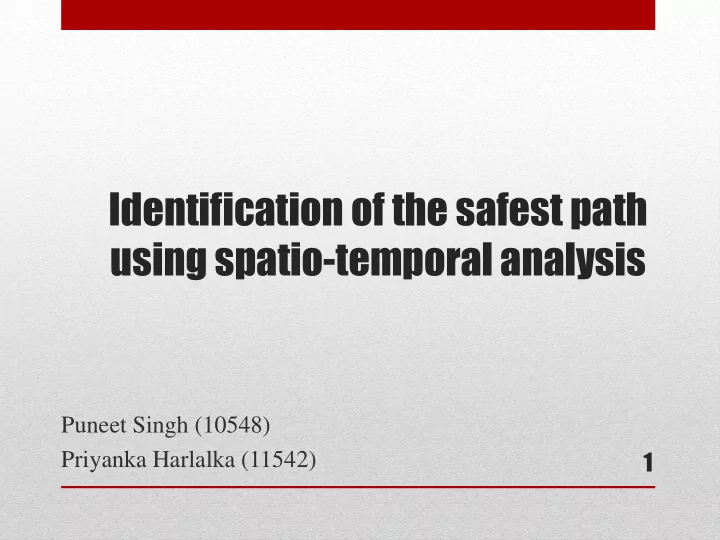

Identification of the safest path using spatio-temporal analysis Puneet Singh (10548) 1 Priyanka Harlalka (11542)
Motivation • In today's society criminal activities are on the rise • We intend to come up with a way by which one can ensure that he travels from one place to the other by the safest route possible • Governments all over the world are spending millions trying to curb this menace 2
Approach News Article Police Record Classification Identification of Location and Date Temporal Analysis Dijkstra’s Algorithm for safest path 3
Classification of articles • We use the Latent Semantic Analysis[1] for classifying articles. • LSA is essentially creating a vector representing a document. • Construct a term-document matrix of the corpus. 4
• Single Value Decomposition (SVD) is then employed to reduce the dimensionality of the matrix. • The LSA helps in grouping words with similar topics together. • Classification using k-nearest neighbors with respect to cosine distances of the document vectors. 5
Identification of Location • Statistical NER methods not well-suited to the dynamic nature of news as noted by Stokes et.al [2] • We use fuzzy geotagging [3] to resolve the bootstrapping problem associated with the traditional method • In fuzzy geotagging a toponym recognition system first finds the toponyms 𝑈 in an article 𝑏 . 0.02 0.015 0.01 0.005 0 1 8 15 22 29 36 43 50 57 64 71 78 85 92 99 106 113 120 127 134 141 148 155 162 169 176 183
• Given a news article, we tag each word with its part of speech, using the POS tagger, and collect all word phrases consisting of proper nouns. • We also apply NER to the article, and collect all phrases tagged as locations. • For resolving the POS tags we use a number of heuristic rules. • Database of geographic locations, is then used to associate each 𝑢 ∈ 𝑈 with the set of all possible interpretations 𝑆 𝑢 • For each 𝑢 and 𝑠 ∈ 𝑆 𝑢 , a weight 𝑥 𝑠 is assigned to 𝑠 using default sense heuristics
Heuristic Rules Source: M.D Liebermann et. al 8
Pseudo-Code 9 Source: M.D Liebermann et. al
Temporal Analysis • Extract the date of the news article/FIR through crawling • We will use a hybridization of artificial neural networks and ARIMA models for time series forecasting[4]. • In an ARIMA (p, d, q) model, the future value of a variable is assumed to be a linear function of several past observations and random errors. 𝜚(𝐶)𝛼 𝑒 (𝑧 𝑢 − 𝜈) = 𝜄 𝐶 𝑏 𝑢 • The parameters are estimated such that an overall measure of errors is minimized 10
• The time series is considered as function of a linear and a nonlinear component. Thus, 𝑧 𝑢 = 𝑔(𝑀 𝑢 , 𝑂 𝑢 ) • After performing ARIMA model at the first stage we assume that the residuals will contain a non-linear relationship. • A multilayer perceptron is used to model the non-linear component existing in the residuals 11
𝑂 1𝑢 = 𝑔 1 (𝑓 𝑢−1 , … , 𝑓 𝑢−𝑜 ) 𝑂 2𝑢 = 𝑔 2 (𝑨 𝑢−1 , … , 𝑨 𝑢−𝑜 ) 𝑂 𝑢 = 𝑔(𝑂 1𝑢 , 𝑂 2𝑢 ) where 𝑔 1 , 𝑔 2 , 𝑔 are the nonlinear functions determined by the neural network. 𝑢 , 𝑂 2𝑢 𝑢) = 𝑔(𝑓 𝑢−1 , . . . , 𝑓 𝑢−𝑜 1 , 𝑀 𝑢 , 𝑨 𝑢−1 , . . . , 𝑨 𝑢−𝑛 1 ) 𝑧 𝑢 = 𝑔(𝑂 1𝑢 , 𝑀 • We will use simple Dijkstra’s algorithm to find the “safest path” based on weights by temporal analysis 12
Dataset 1. Crime records have been extracted from the Delhi Police Website [5] 2. News articles (both crime and non crime) have been extracted from the Times Of India, Hindu etc. Website using a crawler. 3. ACE 2005 English SpatialML Annotations [6] 13
Result and validation • The validation will be a three fold procedure 1. The accuracy for classification of an article as a crime/non-crime 2. Accuracy with which the location can be correctly specified on ACE 2005 dataset 3. Least Square residual for temporal analysis 14
Future Work • Use actual road paths for mapping crime • Include more sources of information for crime hotspot identification 15
References S. T. Dumais “Latent Semantic Anlaysis ”. In: Annual Review of 1. Information Science and Technology vol. 38 (2004), pp. 188-230. N. Stokes, Y. Li, A. Moffat, and J. Rong , “An empirical study of the 2. effects of NLP components on geographic IR performance,” IJGIS, vol. 22(3), 247 – 264, Mar. 2008 M.D Liebermann, H. Samet, J. Sankaranarayanan “ Geotagging with 3. Local Lexicons to Build Indexes for Textually-Specified Spatial Data ”, ICDE Conference 2010, pp: 201 – 212 M. Khashei, M. Bijari, A novel hybridization of artificial neural 4. networks and ARIMA models for time series forecasting, Applied Soft Computing (2011), pp: 2664-2675 5. http://delhipolice.serverpeople.com 6. I. Mani, J. Hitzeman, J. Richer, and D. Harris, ACE 2005 English SpatialML Annotations . Philadelphia, PA: Linguistic Data Consortium, 2008. 16
Questions/Suggestions 17
Recommend
More recommend